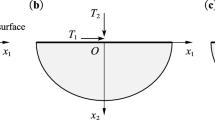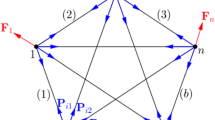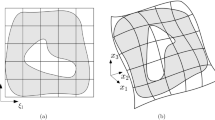Abstract
In this paper, we propose to use a fourth-order partial differential equation (PDE) to solve a class of surface-blending problems. This equation has three vector-valued shape control parameters. It incorporates all the previously published forms of fourth-order PDEs for surface blending and can generate a larger class of blending surfaces than existing equations. To apply the proposed PDE to the solution of various blending problems, we have developed a fast and accurate resolution method. Our method modifies Navier’s solution for the elastic bending deformation of thin plates by making it satisfy the boundary conditions exactly. A comparison between our method, the closed-form solution method, and other existing analytical methods indicates that the developed method is able to generate blending surfaces almost as quickly and accurately as the closed-form solution method, far more efficiently and accurately than the numerical methods and other existing analytical methods. Having investigated the effects that the vector-valued shape parameters and the force function of the proposed equation have on the blending surface, we have found that they have a significant influence on its shape. They provide flexible user handles that surface designers can use to adjust the blending surface to acquire the desired shape. The developed method was employed in the investigation of surface-blending problems where the primary surfaces were expressed in parametric, implicit, and explicit forms.
Similar content being viewed by others
References
Bloor MIG, Wilson MJ (1989) Generating blend surfaces using partial differential equations. Comput Aided Des 21(3):165–171
Bloor MIG, Wilson MJ (1990a) Using partial differential equations to generate free-form surfaces. Comput Aided Des 22(4):202–212
Bloor MIG, Wilson MJ (1990b) Representing PDE surfaces in terms of B-splines. Comput Aided Des 22(6):324–331
Bloor MIG, Wilson MJ (1996) Spectral approximations to PDE surfaces. Comput Aided Des 28(2):145–152
Bloor MIG, Wilson MJ (2000) Method for efficient shape parametrization of fluid membranes and vesicles. Phys Rev E 61(4):4218–4229
Bloor MIG, Wilson MJ, Hagen H (1995) The smoothing properties of variational schemes for surface design. Comput Aided Geom Des 12(4):381–394
Brown JM, Bloor MIG, Susan M, Wilson MJ (1990) Generation and modification of non-uniform B-spline surface approximations to PDE surfaces using the finite element method. In: Ravani B (ed) Advances in design automation, vol 1. Computer Aided and Computational Design, ASME Press, pp 265–272
Cheng SY, Bloor MIG, Saia A, Wilson MJ (1990) Blending between quadric surfaces using partial differential equations. In: Ravani B (ed) Advances in design automation, vol 1. Computer and Computational Design, ASME Press, pp 257–263
Davis J, Marschner SR, Garr M, Levoy M (2002) Filling holes in complex surfaces using volumetric diffusion. In: Proceedings of the 1st international symposium on 3D data processing, visualization, transmission, Padova, Italy 19–21 June 2002, pp 428–438
Du H, Qin H (2000) Direct manipulation and interactive sculpting of PDE surfaces. In: Proceedings of EUROGRAPHICS 2000, Computer Graphics Forum, Interlaken, Switzerland, 20–25 August 2000, 19(3):61–270
Li ZC (1998) Boundary penalty finite element methods for blending surfaces: I. Basic theory. J Comput Math 16:457–480
Li ZC (1999) Boundary penalty finite element methods for blending surfaces: II. Biharmonic equations. J Comput Appl Math 110:55–176
Li ZC, Chang CS (1999) Boundary penalty finite element methods for blending surfaces: III. Superconvergence and stability and examples. J Comput Appl Math 110:241–270
Mimis AP, Bloor MIG, Wilson MJ (2001) Shape parameterization and optimization of a two-stroke engine. J Propulsion Power 17(3):492–498
Rossignac JR, Requicha AAG (1984) Constant-radius blending in solid modeling. Comput Mech Eng 3:65–73
Ugail H, Bloor MIG, Wilson MJ (1999a) Techniques for interactive design using the PDE method. ACM Trans Graph 18(2):195–212
Ugail H, Bloor MIG, Wilson MJ (1999b) Manipulation of PDE surfaces using an interactively defined parameterisation. Comput Graph 23:525–534
Vida J, Martin RR, Varady T (1994) A survey of blending methods that use parametric surfaces. Comput Aided Des 26(5):341–365
Whitaker RT, Breen DE (1998) Level-set models for the deformation of solid objects. In: Proceedings of the conference on implicit surfaces, Seatle, 15–16 June 1998, pp 19–35
You LH, Zhang JJ (2001) Finite difference surface representation considering effect of boundary curvature. In: Proceedings of the 5th international conference on information visualisation, London, 25–27 July 2001. IEEE Press, New York, pp 404–409
You LH, Zhang JJ, Comninos P (1999) Cloth deformation modelling using a plate bending model. In: Proceedings of the 7th international conference in Central Europe on computer graphics, visualisation and interactive digital media, Plzen, Czech Republic, 8–12 February 1999, pp 485–491
You LH, Zhang JJ, Comninos P (2000) A volumetric deformable muscle model for computer animation using weighted residual method. Comput Meth Appl Mech Eng 190:853–863
You LH, Hu JH, Shi YH, Zhang JJ (2003) Single-patch surfaces for tool shape design and finite element analysis of hot metal forming. J Mater Process Technol (in press)
Zhang JJ, You LH (2001) Surface representation using second, fourth and mixed order partial differential equations. In: Proceedings of the international conference on shape modelling and applications, Genoa, Italy, 7–11 May 2001. IEEE Press, New York, pp 250–256
Zhang JJ, You LH (2002) PDE based surface representation – vase design. Comput Graph 26(1):89–98
Zhao H-K, Osher S, Fedkiw R (2001) Fast surface reconstruction using the level set method. In: Proceedings of the IEEE workshop on variational and level set methods in computer vision (VLSM), Vancouver, Canada, 13 July 2001, pp 194–201
Author information
Authors and Affiliations
Corresponding author
Rights and permissions
About this article
Cite this article
You, L., Zhang, J. & Comninos, P. Blending surface generation using a fast and accurate analytical solution of a fourth-order PDE with three shape control parameters. Visual Comp 20, 199–214 (2004). https://doi.org/10.1007/s00371-004-0241-7
Published:
Issue Date:
DOI: https://doi.org/10.1007/s00371-004-0241-7




